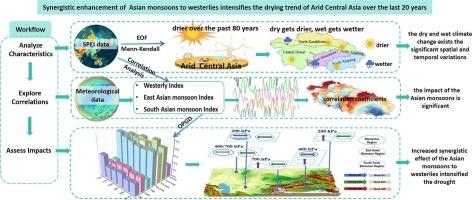过去20年,亚洲季风对西风带的协同增强加剧了中亚干旱地区的干旱趋势
IF 7.2
1区 地球科学
Q1 GEOSCIENCES, MULTIDISCIPLINARY
引用次数: 0
摘要
随着全球变暖的加剧,了解西风带和亚洲季风之间的相互作用对于预测区域气候变化和有效管理水资源变得越来越重要。然而,目前关于这些大气系统如何影响中亚干旱地区干湿气候变化(DWCC)的知识仍然不足。利用标准化降水蒸散发指数(SPEI)和大气环流资料,研究了1940 - 2022年DWCC的长期趋势,并评估了西风带和亚洲季风对ACA的单独和联合影响。结果表明:近80年来,东亚地区夏季气候总体呈偏干燥趋势,从20世纪90年代开始,干旱程度显著增加;在空间上,从东南向西北呈现干湿变化趋势,干旱地区变干,湿润地区变湿。亚洲季风对新疆北部(NX)、天山地区(TM)和中部沙漠(CD) DWCC的影响超过西风带。近20年来,随着西风带的减弱,夏季SPEI与东亚季风指数(EMI)和南亚季风指数(SMI)的相关性增加,表明季风系统的影响越来越大。具体而言,东亚季风(700 hPa以上)和南亚季风(700 hPa以下)的影响增强。西风带和亚洲季风之间的相互作用对DWCC的影响比任何一个系统单独或与第三个系统联合的影响更为明显。特别是在弱(强)西风带和强(弱)季风的条件下,ACA的气候趋于干燥(湿润)。总体而言,过去二十年来,西风带与季风之间日益增强的协同作用加速了东亚地区的干旱化进程。本文章由计算机程序翻译,如有差异,请以英文原文为准。

Synergistic enhancement of Asian monsoons to westerlies intensifies the drying trend of arid Central Asia over the last 20 years
As global warming intensifies, understanding the interactions between the westerlies and Asian monsoons becomes increasingly crucial for predicting regional climate change and managing water resources effectively. However, current knowledge regarding how these atmospheric systems influence dry-wet climate change (DWCC) in Arid Central Asia (ACA) remains insufficient. This study examines the long-term trends in DWCC and evaluates the individual and combined impacts of the westerlies and Asian monsoons on ACA from 1940 to 2022, using the Standardized Precipitation Evapotranspiration Index (SPEI) and atmospheric circulation data. Results indicate that the summer climate in ACA has generally become slightly drier over the past 80 years, with a notable increased in aridity beginning in the 1990s. Spatially, ACA exhibits contrasting dry-wet trends from the southeast to the northwest, with drier areas becoming drier and wetter areas becoming wetter. The influence of Asian monsoons on DWCC in Northern Xinjiang (NX), the Tianshan Mountain area (TM) and the Central Desert (CD) surpasses that of the westerlies. Over the past two decades, as the westerlies weakened, the correlation between the summer SPEI and both the East Asian Monsoon Index (EMI) and South Asian Monsoon Index (SMI) increased, suggesting a growing influence of monsoonal systems. Specifically, the East Asian monsoon (above 700 hPa) and South Asian monsoon (below 700 hPa) demonstrate enhanced effects. The interactive effects between the westerlies and Asian monsoons on DWCC are more pronounced than the influence of either system alone or in combination with a third. Particularly under conditions of weak (strong) westerlies and strong (weak) monsoons, the climate in ACA tends to become drier (wetter). Overall, the increasing synergy between the westerlies to monsoons has accelerated the aridification process in ACA over the past two decades.
求助全文
通过发布文献求助,成功后即可免费获取论文全文。
去求助
来源期刊

Gondwana Research
地学-地球科学综合
CiteScore
12.90
自引率
6.60%
发文量
298
审稿时长
65 days
期刊介绍:
Gondwana Research (GR) is an International Journal aimed to promote high quality research publications on all topics related to solid Earth, particularly with reference to the origin and evolution of continents, continental assemblies and their resources. GR is an "all earth science" journal with no restrictions on geological time, terrane or theme and covers a wide spectrum of topics in geosciences such as geology, geomorphology, palaeontology, structure, petrology, geochemistry, stable isotopes, geochronology, economic geology, exploration geology, engineering geology, geophysics, and environmental geology among other themes, and provides an appropriate forum to integrate studies from different disciplines and different terrains. In addition to regular articles and thematic issues, the journal invites high profile state-of-the-art reviews on thrust area topics for its column, ''GR FOCUS''. Focus articles include short biographies and photographs of the authors. Short articles (within ten printed pages) for rapid publication reporting important discoveries or innovative models of global interest will be considered under the category ''GR LETTERS''.
 求助内容:
求助内容: 应助结果提醒方式:
应助结果提醒方式:


